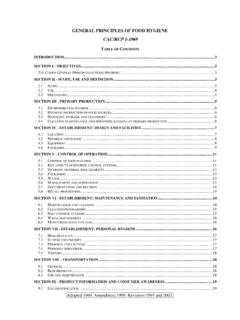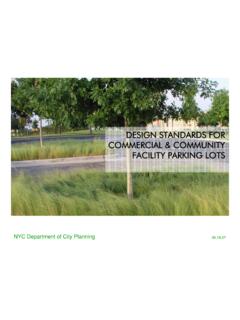Transcription of EJSCREEN Technical Documentation 2014 - environmental …
1 Final, November 2014. EJSCREEN . environmental Justice Mapping and Screening Tool EJSCREEN . Technical Documentation September 2019. EJSCREEN . environmental Justice Mapping and Screening Tool EJSCREEN Technical Documentation September 2019. environmental Protection Agency Office of Policy Washington, 20460. Suggested citation: environmental Protection Agency (EPA), 2019. EJSCREEN Technical Documentation . For more information: ACKNOWLEDGEMENTS. This document was prepared by the United States environmental Protection Agency's Office of Policy (OP) and Office of environmental Justice (OEJ) with drafting, editing and Technical support from Abt Associates, ESRI and SAIC, working with the Office of environmental Information (OEI), obtained and processed datasets obtained from the Census Bureau, US Department of Transportation (DOT), and various EPA offices including the Office of Air (OAR), Office of Research and Development (ORD), Office of Water (OW), and Office of Land and Emergency Management (OLEM).
2 Ongoing input, review, and outreach have been provided by all of these offices as well as EPA's Regional offices, Office of Chemical Safety and Pollution Prevention (OCSPP), Office of International and Tribal Affairs (OITA), Office of Enforcement and Compliance Assurance (OECA), and Office of General Counsel (OGC). External expert peer reviewers provided comments on the methods and Documentation as well. Specific acknowledgement is given to the contributions of Mark Corrales, Bridgid Curry, William Nickerson, Tai Lung and Fred Talcott in the design of EJSCREEN and the preparation of this document. Contents 1 INTRODUCTION .. 6. environmental JUSTICE AT EPA .. 6. environmental JUSTICE MAPPING AND SCREENING AT EPA.
3 7. DEVELOPMENT OF EJSCREEEN .. 7. PURPOSES AND USES OF 8. CAVEATS AND LIMITATIONS OF EJSCREEN .. 9. ADVANCES IN EJ SCREENING PROVIDED BY EJSCREEN .. 11. 2 OVERVIEW OF DATA AND METHODS IN EJSCREEN .. 13. environmental INDICATORS SELECTED FOR EJSCREEN .. 13. DEMOGRAPHICS IN EJSCREEN .. 16. Using Demographics as Proxies for Potential Susceptibility .. 16. Demographic Indicators Included in EJSCREEN .. 20. Demographic Indexes in EJSCREEN .. 21. environmental JUSTICE INDEXES IN 22. How the EJ Index Works .. 22. EJ Indexes, Population Density, and Rural Areas .. 24. Why the EJ Indexes are Not all Combined .. 24. PERCENTILES .. 26. What a Percentile Means .. 26. Color-coded High Percentile Bins .. 26. BUFFER REPORTS.
4 28. What the Buffer Report Calculates .. 28. Choosing a Buffer Size versus Rationale for Distance in Proximity Indicators .. 29. 3 DETAILS ON THE environmental INDICATORS IN EJSCREEN .. 31. environmental INDICATORS NOT INCLUDED .. 31. environmental INDICATORS IN EJSCREEN .. 33. 4 BIBLIOGRAPHY .. 65. Appendices Appendix A. Development of EJSCREEN .. 76. Appendix B. Technical details on percentiles, rounding, buffering, and demographic data .. 78. Appendix C. Technical details on proximity indicators .. 97. Appendix D. Summary statistics for indicators .. 106. Appendix E. Formulas for demographics and EJ 109. Appendix F. Quality control / quality 110. Appendix G. Peer review .. 112. Appendix H. Initial filter approach for screening.
5 114. iv | P a g e Tables Table 1. Types of environmental Indicators Included in EJSCREEN .. 15. Table 2. Summary Table of environmental Indicators and Sources .. 33. Table 3. Likelihood of Lead-Based Paint Hazards by Housing Construction Date .. 47. Table 4. Tallies of 2011-17 ACS Block Groups Used in 2019 Version of EJSCREEN .. 83. Table 5. ACS Tables Underlying EJSCREEN Demographic Data and Lead Paint Indicator .. 84. Table 6. Summary Statistics for environmental Indicators .. 106. Table 7. Summary Statistics for Demographics .. 107. v|Page Introduction EJSCREEN environmental Justice Mapping and Screening Tool Technical Documentation 1 INTRODUCTION. The United States environmental Protection Agency (EPA) is charged with protecting human health and the environment for all Americans.
6 In order to better meet the Agency's responsibilities related to the protection of public health and the environment, EPA has developed an environmental justice (EJ). screening tool, called EJSCREEN . In some ways, EJSCREEN is similar to prior screening or mapping tools. As a newer tool, however, it offers improvements such as easy web-based access to powerful mapping and data reporting tools, a wide range of updated demographic information, environmental indicators addressing more topics, and higher resolution maps covering the entire nation. EJSCREEN also provides standard reports that bring together environmental and demographic data in the form of EJ indexes. These are summarized as percentiles to put the information in perspective and facilitate comparisons between locations.
7 EJ screening tools may be used to explore one location using a data report, or to look across a wide area using maps. EJ tools have been used in a wide variety of circumstances, and EJSCREEN can support a similarly broad range of applications. EJSCREEN provides useful data and indicators, and highlights places that may be candidates for further review, including additional consideration, analysis or outreach. This document describes EJSCREEN within the context of EPA's EJ program, and provides details on the data and methods used to create the indicators and indexes in EJSCREEN . The Appendices in this document provide additional detail on data and methods for interested users. environmental Justice at EPA. Since EJ mapping and screening is just one aspect of EPA's ongoing commitment to environmental justice, it is helpful to understand the broad, historical context of EPA's EJ work.
8 EPA has defined environmental justice as follows: environmental Justice is the fair treatment and meaningful involvement of all people regardless of race, color, national origin, or income with respect to the development, implementation, and enforcement of environmental laws, regulations, and policies. Fair treatment means that no group of people should bear a disproportionate share of the negative environmental 6|Page Introduction consequences resulting from industrial, governmental and commercial operations or policies. 1. (italics added). EPA's efforts to understand EJ concerns date back at least to EPA's 1992 report on environmental Equity ( EPA, 1992). The 1992 report documented health and exposure disparities associated with race/ethnicity and income.
9 To address such disparities, in 1994, Executive Order 12898 (EO 12898). mandated that each covered federal agency make achieving environmental justice part of its mission by identifying and addressing, as appropriate, any disproportionately high and adverse human health or environmental effects of its programs, policies and activities on minority, low-income, tribal and indigenous populations. 2 These early activities provided a foundation for EPA's continued commitment to environmental justice. EPA has been engaged in a variety of research and analytic efforts related to environmental justice, to support both regulatory analysis and screening efforts. The original EJSCREEN efforts were guided by Plan EJ 2014, which was released in September 2011.
10 3 EPA's Office of environmental Justice (OEJ), in conjunction with the rest of the Agency, works to protect human health and the environment in communities overburdened by environmental pollution by integrating environmental justice into all EPA. programs, policies and activities. environmental Justice Mapping and Screening at EPA. Mapping tools as well as screening-level applications have a substantial history at EPA, and EJ is one area in which maps and screening can be useful. Several EPA Regional offices have used basic screening tools that map demographic information and allow staff to overlay selected environmental data such as facility locations. In connection with EJSEAT, a screening tool that was developed by EPA's Office of Enforcement and Compliance Assurance (OECA), the National environmental Justice Advisory Council (NEJAC) provided recommendations to EPA about how to design an EJ screening tool in its May 2010.


















